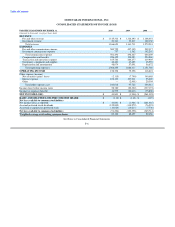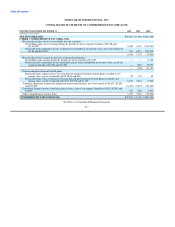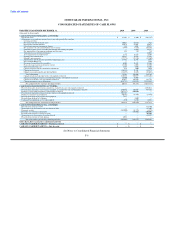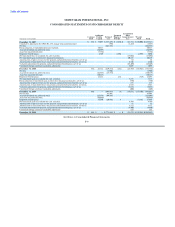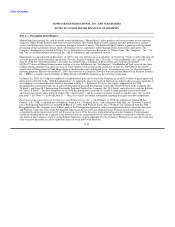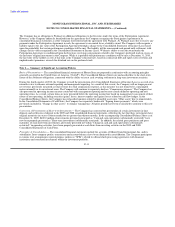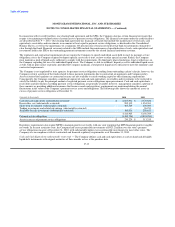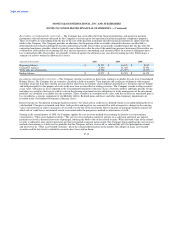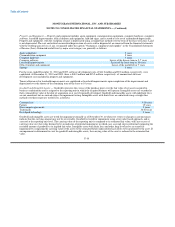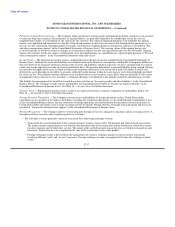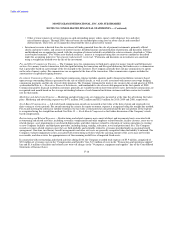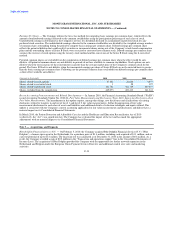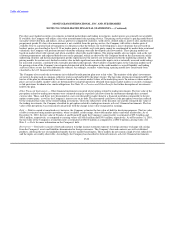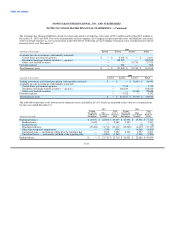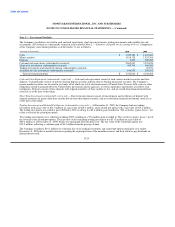MoneyGram 2010 Annual Report Download - page 100
Download and view the complete annual report
Please find page 100 of the 2010 MoneyGram annual report below. You can navigate through the pages in the report by either clicking on the pages listed below, or by using the keyword search tool below to find specific information within the annual report.
Table of Contents
MONEYGRAM INTERNATIONAL, INC. AND SUBSIDIARIES
NOTES TO CONSOLIDATED FINANCIAL STATEMENTS — (Continued)
Securities with gross unrealized losses at the balance sheet date are subject to a process for identifying other-than-temporary impairments.
Securities that the Company deems to be other-than-temporarily impaired are written down to fair value in the period the impairment
occurs. The assessment of whether such impairment has occurred is based on management's evaluation of the underlying reasons for the
decline in fair value on an individual security basis. The Company considers a wide range of factors about the security and uses its best
judgment in evaluating the cause of the decline in the estimated fair value of the security and the prospects for recovery. The Company
considers an investment to be other-than-temporarily impaired when it is deemed probable that the Company will not receive all of the
cash flows contractually stipulated for the investment. The Company evaluates mortgage-backed and other asset-backed investments
rated A and below for which risk of credit loss is deemed more than remote for impairment. When an adverse change in expected cash
flows occurs, and if the fair value of a security is less than its carrying value, the investment is written down to fair value through a
permanent reduction to its amortized cost. Securities gains and losses are recognized upon the sale, call or maturity of securities using the
specific identification method to determine the cost basis of securities sold. Unrealized gains and losses resulting from changes in the fair
value of trading investments and put options related to trading investments are recognized in the period in which the change occurs. Any
impairment charges and other securities gains and losses are included in the Consolidated Statements of Income (Loss) under "Net
securities (gains) losses."
Payment Service Obligations — Payment service obligations primarily consist of: outstanding payment instruments; amounts owed to
financial institutions for funds paid to the Company to cover clearings of official check payment instruments, remittances and clearing
adjustments; amounts owed to agents for funds paid to consumers on behalf of the Company; commissions owed to financial institution
customers and agents for instruments sold; amounts owed to investment brokers for purchased securities; and unclaimed instruments
owed to various states. These obligations are recognized by the Company at the time the underlying transactions occur.
Fair Value of Financial Instruments — Financial instruments consist of cash and cash equivalents, investments, derivatives and debt. The
carrying values of cash and cash equivalents and short-term investments approximate fair value due to the short-term nature of these
instruments. The carrying value of the Company's senior facility approximates fair value as interest related to the debt is variable rate.
The carrying value of the Company's fixed-rate notes also approximates fair value as the contractual interest rate is comparable to debt
with similar maturities issued by companies with similar credit qualities. See Note 4 — Fair Value Measurement for information
regarding the principles and processes used to estimate the fair value of investments and derivatives.
Derivative Financial Instruments — The Company recognizes derivative instruments in the Consolidated Balance Sheets at fair value.
The accounting for changes in the fair value depends on the intended use of the derivative and the resulting designation. For a derivative
instrument designated as a fair value hedge, the Company recognizes the change in fair value in earnings in the period of change, together
with the offsetting change in the hedged item. For a derivative instrument designated as a cash flow hedge, the Company initially reports
the effective portion of the derivative's change in fair value in "Accumulated other comprehensive loss" in the Consolidated Balance
Sheets, and subsequently reclassifies the net change in fair value into earnings when the hedged exposure affects earnings.
The Company evaluated the hedge effectiveness of its derivatives designated as cash flow hedges at inception and on an on-going basis.
Hedge ineffectiveness, if any, is recorded in earnings on the same line as the underlying transaction risk. When a derivative is no longer
expected to be highly effective, hedge accounting is discontinued. Gain or loss on derivatives designated as cash flow hedges that were
terminated or discontinued was recorded in "Investment commissions expense" or "Interest expense" in the Consolidated Statements of
Income (Loss) based on the underlying transaction risk the derivative was originally hedging. For a derivative instrument that does not
qualify, or is not designated, as a hedge, the change in fair value is recognized in "Transaction and operations support" under the
operating section or in "Other" expense in the non-operating section in the Consolidated Statements of Income (Loss) based on the
Company's purpose for entering into the derivatives.
Cash flows resulting from derivative financial instruments are classified in the same category as the cash flows from the items being
hedged. The Company does not use derivative instruments for trading or speculative purposes.
F-15



